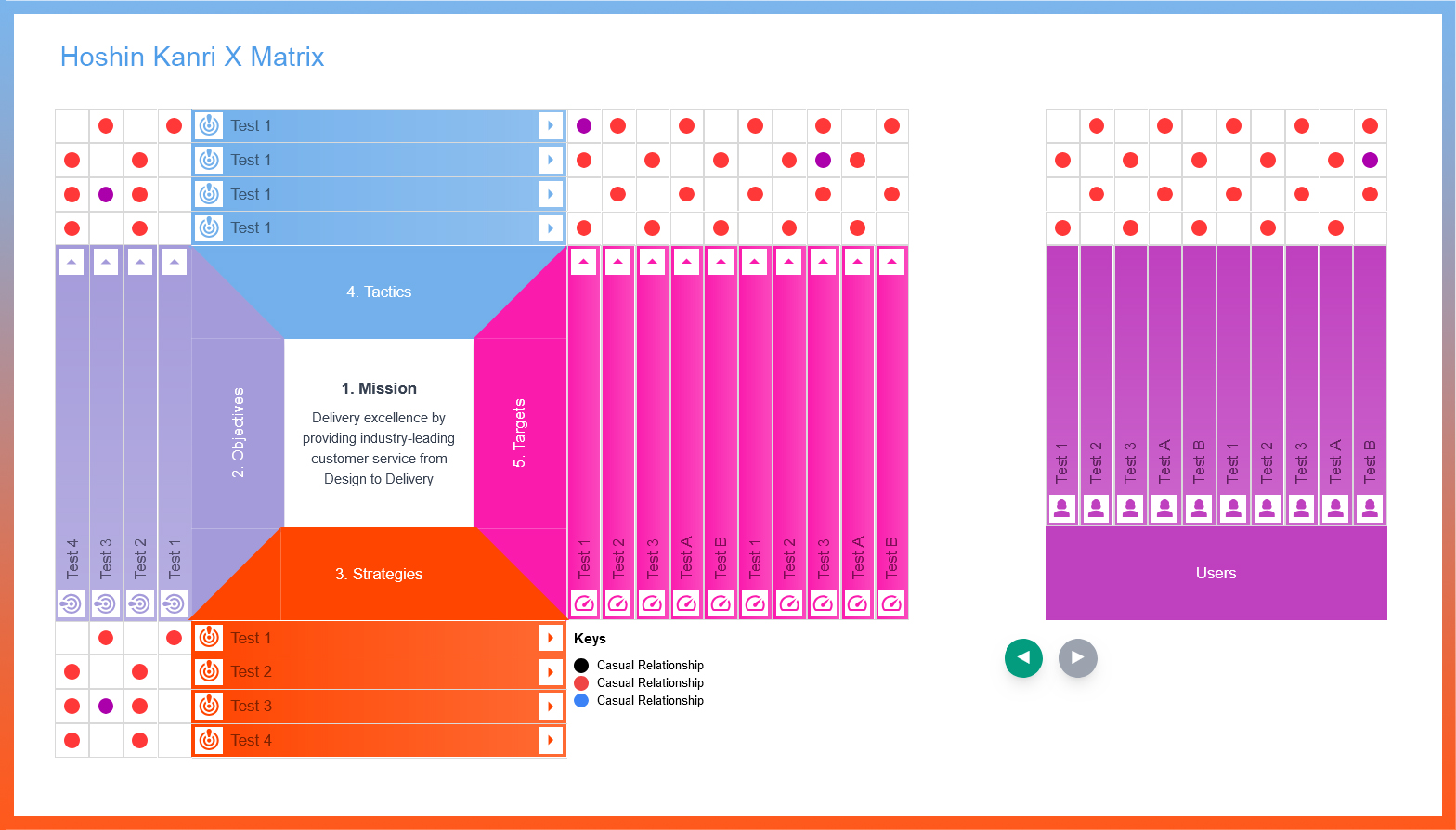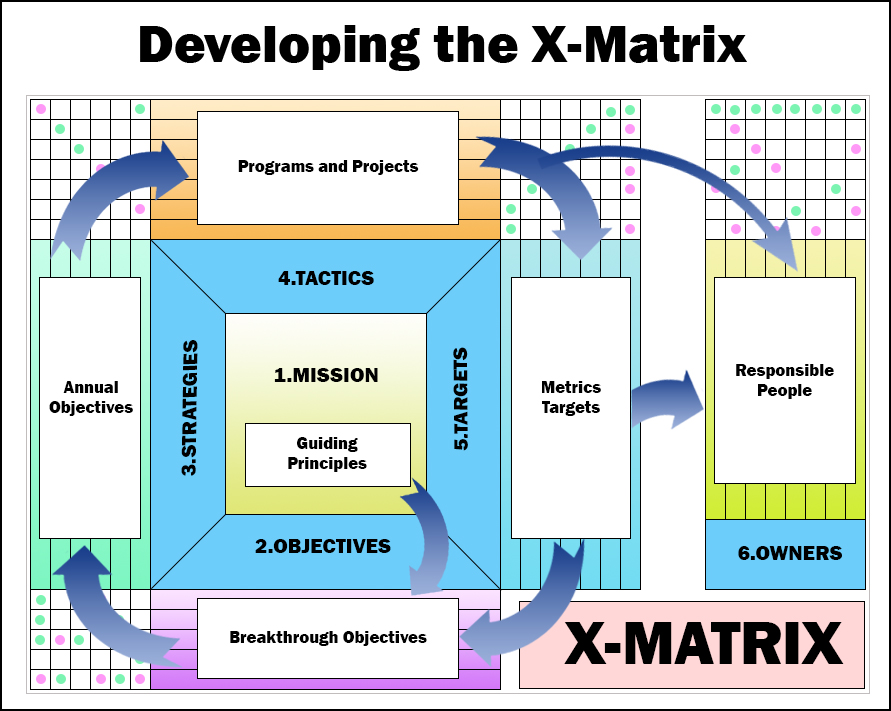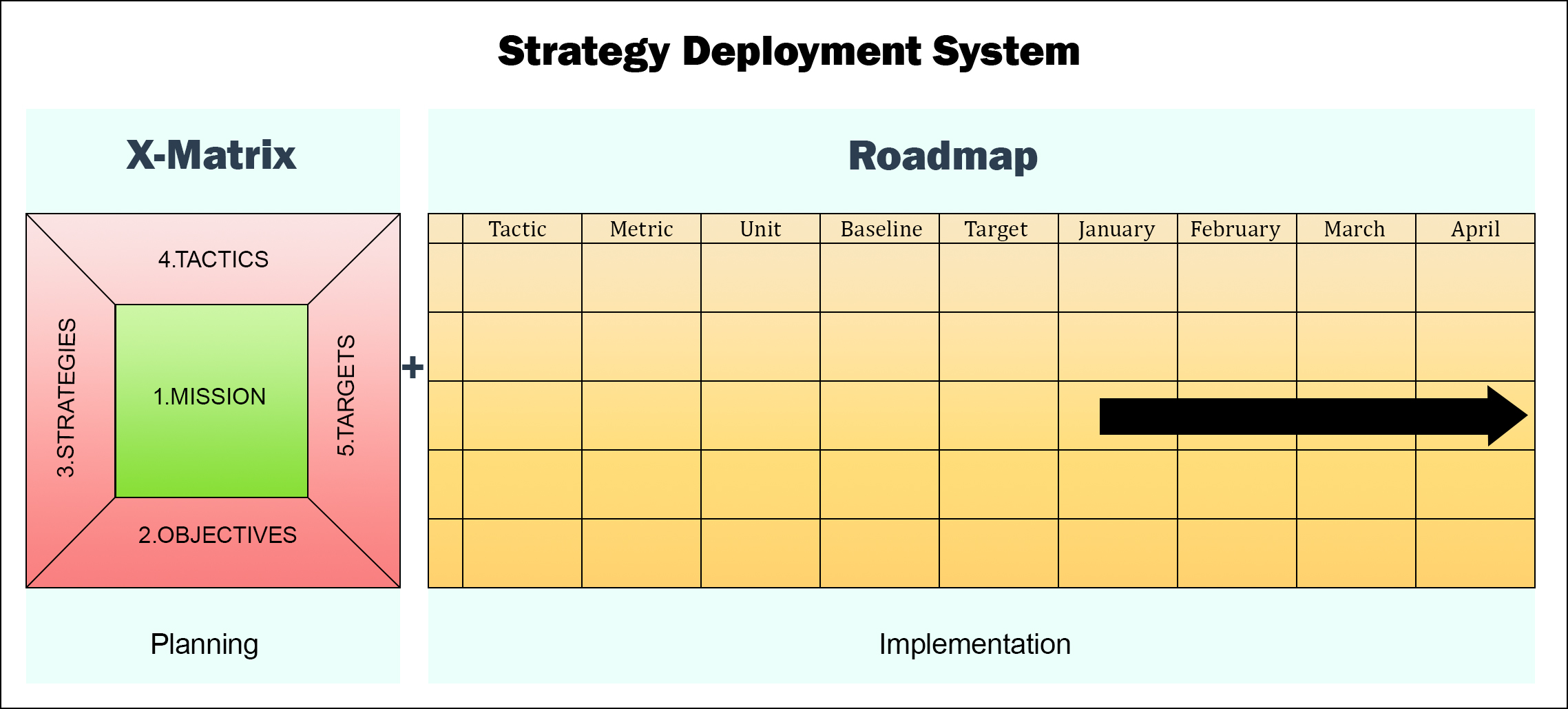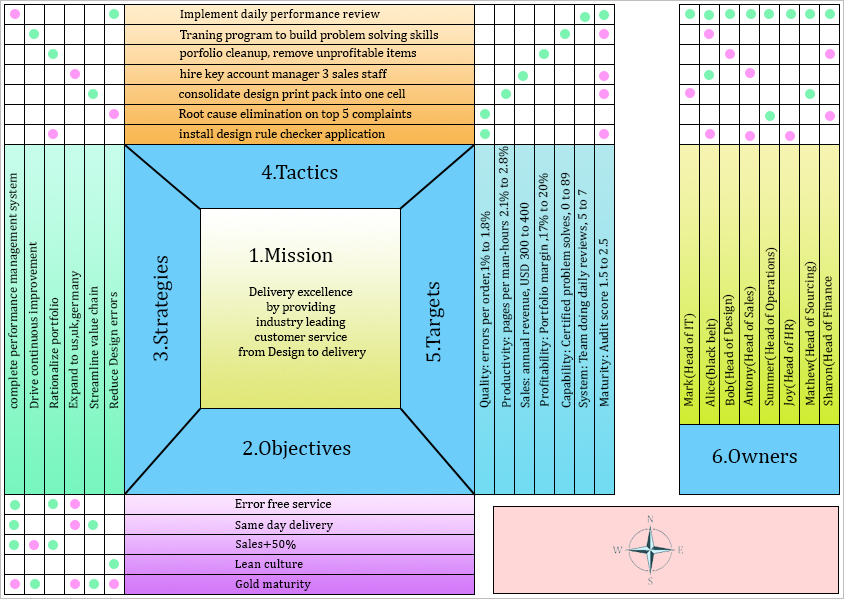X Matrix for Strategy Deployment
Developing the X Matrix is a crucial step in implementing Hoshin Kanri for effective strategic planning. The X Matrix aligns an organization’s strategic goals with actionable initiatives and metrics.

Here’s a step-by-step guide to developing the X Matrix:
1. Define Strategic Objectives
Start by clearly defining your organization's long-term strategic objectives. These should be broad, high-level goals that guide the overall direction of your organization. Ensure these objectives are specific, measurable, achievable, relevant, and time-bound (SMART).
2. Identify Key Performance Indicators (KPIs)
Determine the KPIs that will measure progress towards each strategic objective. KPIs should be aligned with your goals and provide a clear indication of success. These indicators help track performance and ensure that objectives are being met.

3. Establish Annual Objectives
Break down the strategic objectives into annual goals or targets. These should be specific milestones that contribute to achieving the long-term objectives. Annual objectives should be actionable and include deadlines.
4. Define Actions and Responsibilities
For each annual objective, identify the key actions or projects required to achieve it. Assign responsibilities to team members or departments, ensuring that everyone understands their role in reaching the objectives.
5. Create the X Matrix
Organize the information into the X Matrix format. The matrix typically includes:
- Top Left: Strategic Objectives
- Top Right: Annual Objectives
- Bottom Left: Key Actions/Projects
- Bottom Right: KPIs
6. Ensure Alignment
Verify that the actions and KPIs are aligned with the strategic and annual objectives. The matrix should clearly show how each action contributes to achieving the goals and how progress will be measured.
7. Review and Adjust
Regularly review the X Matrix to track progress and make adjustments as needed. Ensure that the matrix remains relevant and reflects any changes in the strategic direction or external environment.
8. Communicate and Implement
Share the X Matrix with all relevant stakeholders to ensure alignment and understanding. Implement the actions outlined in the matrix and monitor progress through regular updates and reviews.
Example of an X Matrix Layout
+-------------------------+--------------------------+ | Strategic Objectives | Annual Objectives | +-------------------------+--------------------------+ | 1. Increase Market Share| 1.1 Launch New Product | | 2. Improve Customer | 2.1 Enhance Customer | | Satisfaction | Service | +-------------------------+--------------------------+ | Key Actions/Projects | KPIs | +-------------------------+--------------------------+ | 1. Develop marketing | 1.1 Product Launch | | campaign for new | Success Rate | | product | 2.1 Customer Satisfaction| | 2. Train customer | Score | | service team | | +----------------------------------------------------+
The X Matrix is a dynamic tool that should evolve as your strategy and goals develop. By following these steps, you can create a clear, actionable plan that drives your organization’s success.
How Organisations Benefit Using X-Matrix

1. Clear Alignment of Goals
Benefit: Ensures that all strategic objectives are directly aligned with actionable tasks and performance metrics.
Explanation: By visualizing the connection between high-level strategic goals and daily actions, the X-Matrix helps organizations ensure that every activity contributes to overarching objectives. This alignment reduces miscommunication and ensures that everyone is working towards the same goals.
2. Improved Visibility and Focus
Benefit: Provides a comprehensive view of strategic priorities and progress.
Explanation: The X-Matrix lays out strategic objectives, annual goals, key actions, and KPIs in a single visual format. This visibility helps organizations maintain focus on key priorities and track progress efficiently, making it easier to identify areas that need attention.
3. Enhanced Accountability
Benefit: Clarifies responsibilities and ownership of tasks.
Explanation: By assigning specific actions and projects to individuals or teams within the X-Matrix, organizations can improve accountability. Clear assignments ensure that team members understand their roles and responsibilities in achieving the strategic goals.
4. Better Resource Allocation
Benefit: Optimizes the use of resources based on strategic priorities.
Explanation: With a clear view of priorities and required actions, organizations can allocate resources more effectively. The X-Matrix helps in identifying which areas require more attention and resources, ensuring that critical initiatives are adequately supported.
5. Continuous Improvement
Benefit: Facilitates regular review and adjustment of strategies.
Explanation: The X-Matrix is not a static tool but a dynamic one that can be regularly reviewed and updated. This flexibility allows organizations to adapt to changes in the business environment, adjust strategies as needed, and continuously improve their processes and performance.
6. Enhanced Communication and Collaboration
Benefit: Promotes effective communication and teamwork.
Explanation: The X Matrix serves as a central communication tool that helps ensure that all team members are on the same page regarding strategic goals and actions. It fosters collaboration by making objectives and progress visible to all stakeholders.
7. Measurable Results
Benefit: Provides a framework for tracking and measuring success.
Explanation: The inclusion of KPIs in the X-Matrix enables organizations to measure progress towards strategic goals. By monitoring these indicators, organizations can assess their performance, make data-driven decisions, and demonstrate the impact of their strategies.
8. Strategic Focus
Benefit: Keeps the organization focused on long-term goals while managing short-term tasks.
Explanation: The X Matrix helps organizations balance short-term actions with long-term strategic objectives. It ensures that day-to-day tasks and projects are aligned with the larger strategic vision, preventing distractions and maintaining strategic focus.
Hoshin Kanri X Matrix for Strategic Planning -Faq
What is the Hoshin Kanri X Matrix?
The Hoshin Kanri X Matrix is a strategic planning tool used to align an organization’s long-term goals with its short-term objectives and actions. It visually maps out strategic objectives, annual goals, key actions, and key performance indicators (KPIs) in a matrix format. This tool helps ensure that all parts of the organization are working towards the same strategic objectives and allows for better tracking and alignment of efforts.

How does the X Matrix help with strategic planning?
The X Matrix helps with strategic planning by providing a clear visual representation of how strategic goals are connected to annual objectives, key actions, and performance measures. This alignment helps organizations ensure that every action taken is contributing to the broader strategic goals. It facilitates communication, enhances transparency, and helps teams stay focused on achieving their targets.
What are the main components of the X Matrix?
The main components of the X Matrix are:
- Strategic Objectives: Long-term goals that define the organization’s vision and direction.
- Annual Objectives: Specific targets or milestones to be achieved within the year that contribute to the strategic objectives.
- Key Actions: Specific tasks or projects required to achieve the annual objectives.
- KPIs (Key Performance Indicators): Metrics used to measure progress towards the annual objectives and strategic goals.
How do you create an effective X Matrix?
To create an effective X Matrix, follow these steps:
- Define Strategic Objectives: Start by identifying long-term goals.
- Set Annual Objectives: Break down these goals into specific yearly targets.
- Identify Key Actions: Determine the actions required to meet each annual objective.
- Establish KPIs: Select performance indicators to measure progress.
- Organize the Matrix: Populate the matrix with these components, ensuring alignment and clarity.
- Communicate and Deploy: Share the matrix with stakeholders and ensure understanding.
How often should the X Matrix be reviewed and updated?
The X Matrix should be reviewed regularly, typically on a quarterly basis, to ensure that it remains relevant and accurate. During these reviews, assess progress against KPIs, address any issues, and make adjustments to objectives or actions as needed. Annual reviews are also important to align the X Matrix with any changes in the organization’s strategic direction or external environment.
What are the benefits of using the X Matrix?
The benefits of using the X Matrix include:
- Alignment: Ensures that all organizational activities are aligned with strategic goals.
- Visibility: Provides a clear, visual representation of objectives and progress.
- Accountability: Clarifies responsibilities and ownership of actions.
- Focus: Helps maintain focus on key priorities and actions.
- Performance Tracking: Facilitates monitoring of progress and performance measurement.
Who should be involved in creating the X Matrix?
Key stakeholders involved in creating the X Matrix should include senior leadership, strategic planning teams, department heads, and individuals responsible for implementing actions. It is crucial to involve those who have a deep understanding of the organization’s strategy and those who will be executing the actions to ensure that the matrix is accurate and actionable.
How does the X Matrix integrate with other strategic tools?
The X Matrix integrates with other strategic tools by providing a comprehensive framework that aligns with various planning methodologies. It can be used in conjunction with tools like SWOT analysis, Balanced Scorecard, and strategic roadmaps to ensure consistency and coherence in strategic planning and execution.
Can the X Matrix be customized for different industries?
Yes, the X Matrix can be customized for different industries. The core principles of the X Matrix remain the same, but the specific strategic objectives, annual goals, key actions, and KPIs will vary depending on the industry and organizational context. Customization ensures that the matrix is relevant and effective for different business environments.
What challenges might organizations face when implementing the X Matrix?
Common challenges when implementing the X Matrix include:
- Resistance to Change: Teams may be resistant to adopting new planning tools or processes.
- Alignment Issues: Ensuring that all levels of the organization are aligned with the strategic objectives can be difficult.
- Data Accuracy: Maintaining accurate and up-to-date data for KPIs and progress tracking.
- Complexity: The matrix can become complex if not managed properly, requiring clear communication and training.
Addressing these challenges involves clear communication, training, and regular reviews to ensure successful implementation and use of the X Matrix.
What is a Hoshin Kanri Catchball?
Hoshin Kanri Catchball is a communication and feedback process used in the Hoshin Kanri strategic planning methodology. It involves a back-and-forth exchange of ideas and information between different levels of the organization. The "catchball" metaphor describes how strategic goals and plans are tossed back and forth between top management and employees. This iterative process helps refine goals, align objectives, and ensure that all levels of the organization understand and commit to the strategic plan. It promotes collaboration, clarity, and ownership of the strategic initiatives.
What are Hoshin Pillars?
Hoshin Pillars are the foundational elements or key areas of focus in the Hoshin Kanri methodology. They represent the critical strategic goals or themes that an organization prioritizes to achieve its vision. These pillars help guide the organization’s efforts and resources toward the most important objectives. Hoshin Pillars typically include:
- Strategic Objectives: Long-term goals that define the organization's vision and direction.
- Annual Objectives: Specific targets or milestones to be achieved within a year that support the strategic objectives.
- Key Actions: Concrete steps or initiatives required to achieve the annual objectives.
- Key Performance Indicators (KPIs): Metrics used to measure progress towards the objectives.
How to Use the Hoshin Kanri X Matrix for Strategic Planning?
The Hoshin Kanri X Matrix is a tool used to align and manage strategic planning efforts. Here’s how to use it effectively:
- Define Strategic Objectives:
- Identify long-term goals that reflect the organization’s vision and mission.
- These objectives should be broad, high-level goals that guide the overall direction.
- Set Annual Objectives:
- Break down the strategic objectives into specific, actionable annual targets.
- These objectives should be achievable within the year and contribute to the strategic goals.
- Determine Key Actions:
- Identify the key actions or projects needed to achieve each annual objective.
- These actions should be concrete tasks or initiatives that will drive progress towards the objectives.
- Establish KPIs:
- Set Key Performance Indicators to measure progress towards the annual objectives.
- KPIs should be specific metrics that provide insights into the effectiveness of the actions and achievement of objectives.
- Organize the Matrix:
- Populate the X Matrix with the strategic objectives, annual objectives, key actions, and KPIs.
- The matrix typically has four quadrants: Strategic Objectives (top-left), Annual Objectives (top-right), Key Actions (bottom-left), and KPIs (bottom-right).
- Align and Communicate:
- Ensure that all components of the matrix are aligned and that there is a clear link between strategic goals and daily activities.
- Communicate the matrix to all relevant stakeholders to ensure understanding and buy-in.
- Implement and Monitor:
- Execute the key actions outlined in the matrix.
- Regularly monitor progress using the KPIs and make adjustments as needed.
- Review and Adjust:
- Periodically review the X Matrix to assess progress and make necessary adjustments.
- Update the matrix to reflect any changes in strategy or priorities.
The X Matrix helps visualize the alignment between strategic goals, annual targets, actions, and performance measures, ensuring a cohesive approach to achieving organizational objectives.